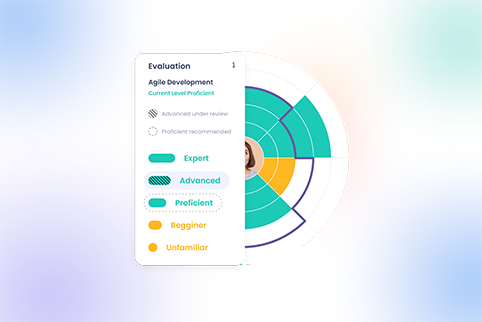Lateral Moves: Benefits, Examples, and Tips for Organizations
10 min read

The traditional trajectory of climbing the corporate ladder in a linear fashion is slowly but steadily being accompanied by a new approach: lateral moves.
And as HR professionals and people managers, it’s crucial to recognize the significance and increasing demand for lateral transitions — as well as their potential impact on both individual career development and organizational success.
This trend has been picking up considerable momentum in recent years, with more professionals opting for lateral moves to diversify their skills, explore new opportunities, or apply their expertise in different areas. But what are the benefits of such moves and how can modern organizations facilitate them? Let’s find out!
What are lateral moves?
Lateral (career) moves or transfers represent the internal transitions made by employees from one role to another without changing their seniority level.
In other words, a lateral move isn’t a promotion or a demotion, and while the new role will naturally involve different responsibilities those will not usually be beyond the worker’s current skill set and expertise. The salary will also stay more or less the same.
Unlike vertical moves, which focus more on upskilling, lateral transitions enable the possibility to cross-skill or even reskill, depending on what’s expected from people in the new roles and how their skills compare with the new day-to-day tasks.
Both employees and employers can suggest or express interest in a lateral move and after it is agreed by both parties some onboarding process might be necessary.
What are the benefits of lateral moves?
Support employee growth and career development
Lateral moves enable and encourage workers to enhance their skill set, by applying their know-how to different projects and business areas, by putting to good use underutilized capabilities, or by working on adjacent skills, which are more easily developed.
For instance, someone who works in a back-office role could move to a more client-facing one, or the move might involve a switch from operating independently to becoming an integral part of a (new) team. In these particular examples, the move would represent an excellent opportunity to improve soft or human skills — expected to become the skills of the future in an AI-driven and automated world.
This is extremely important and relevant in a work environment where skills-based and skills-first approaches are becoming the new norm because these will redefine not only hiring and career pathing but the entire talent journey, which impacts employees and employers alike.
Nurture a dynamic and versatile workforce
As highlighted earlier, vertical moves are more likely to help workers enhance their skills and reach higher proficiency levels. Lateral transfers, however, are different. They allow people to broaden their abilities and have a more versatile skill set.
This skills versatility is essential for modern businesses because it acts as the basis for building a more dynamic and agile workforce, which is more capable of facing unfamiliar challenges and easier to redeploy and assemble (and disassemble) in temporary teams that meet the ever-changing priorities of your company.
Improve employee retention rates
Statistics are now proving (and have been doing so for some time) that modern workers place great value on growth, learning opportunities, and flexibility. So much so that:
Workers who have moved internally have a 64% chance of remaining with an organization after three years.
— LinkedIn
And this aspect is what makes lateral moves such an exciting proposition for modern organizations. These internal moves meet some of the core needs and aspirations of your workers and have the power to significantly extend their tenure.
And why does this matter so much now? Because skill gaps and talent shortages are more prevalent than ever before, and keeping top talent is therefore critical for long-term business success.
Ensure sustainable engagement and satisfaction levels
Whether in relation to marketing, social media, or your workforce, ‘engagement’ has become somewhat of a buzzword. Be that as it is, the truth is employees find it particularly challenging to remain engaged and motivated once they feel they’ve learned everything there is to learn in their current role.
This can happen due to the limitations of the role itself or the lack of employee growth opportunities in general (which is a much bigger problem). Either way, lateral moves can open the door to new experiences and learning in the flow of work through interactions with new people, often from other departments or business areas.
This renewed sense of novelty will naturally bring back excitement and curiosity and encourage your employees to tackle different types of projects or work with unfamiliar cutting-edge tools — which is bound to not only keep them engaged but also prevent more serious problems, like the risk of burn out or a lack of satisfaction due to stagnation in the current job.
Example of a lateral career move
In our made-up example, Olivia is a skilled mid-level data scientist working at a large e-commerce company. Olivia has been crunching numbers and building predictive models for some years now, but lately, she’s been craving a change of scenery and the need to explore her more creative and social side in addition to her technical skills.
She loves the company and work environment, so instead of seeking opportunities elsewhere, she decides to explore options for a lateral career move available internally. That’s how she eventually makes the transition to a mid-level marketing analyst position in the marketing department.
In her new role, Olivia applies her expertise in data analysis to help her new colleagues better understand:
- customer behavior patterns
- campaign performance metrics
- and market trends
She leverages her statistical knowledge to conduct in-depth analyses of marketing campaigns and identifies new opportunities for optimization and growth.
This lateral career move helps Olivia apply her hard skills in a different environment and work on key soft skills — e.g., collaboration, communication, and presentation — with the potential of unlocking entirely new career paths going forward.
She is also gaining a deeper understanding of the company’s overall operations and objectives. And thanks to her work and unique perspectives she is now helping uncover insights that drive sustainable business development.
How organizations can enable lateral moves
Having already established their importance and benefits, let’s look at what your organization can do to facilitate and support these internal transfers:
Shift from traditional to non-linear career paths
Linear career paths have been the norm for a long time, but that’s changing. Why?
Partly because they are inherently limited. Not everyone can or has the opportunity to climb up the career ladder. Even an incredibly useful process like succession planning can backfire when too many candidates with leadership potential are selected, and trained, but don’t have the chance to take on business-critical roles afterward.
There’s also a shift in the expectations and priorities of newer work generations (like Gen Z), who prioritize overall well-being and flexibility ahead of other things. So, what can organizations do?
Embrace and include in their talent strategies non-linear or dynamic career paths, which are all about:
- encouraging employees to explore diverse roles and experiences across different departments
- developing new skills and expertise that are relevant and applicable both now and in the future
- supporting organizational and workforce agility
Learn more about non-linear career paths.
Make lateral career moves transparent with an internal talent marketplace
Embracing lateral transfers — as well as other moves and L&D opportunities in general — will only succeed if employees in your company know about them and have the necessary information to decide what (lateral) move would be most suitable for them and where they can apply.
A talent marketplace solves all these challenges and many others by bringing together all internal opportunities in a centralized and organized place. This includes everything, from short-term projects and assignments to coaching and mentorship and, of course, part- and full-time open roles (vertical, lateral, and cross-departmental).
The internal talent marketplace will bring visibility and transparency to lateral moves and will allow anyone, regarding of their previous experience, to see how well they match with any given opportunity and apply if they meet the criteria.
And since these moves are posted in the marketplace by HR in collaboration with decision-makers and team leaders, they are always aligned with the larger business and development goals of your organization — all while providing people the flexibility and novelty they seek in their careers.
Learn more about the power and benefits of an internal talent marketplace.
Take employee growth plans seriously
When implemented well and with flexibility in mind, employee growth plans can bring excellent results in terms of professional development and also reveal interesting insights during evaluations.
For instance, an employee growth plan could be the starting point or the key resource showcasing that an employee no longer has enough worthwhile (learning) objectives related to their current position — or that maybe they are interested in growing and applying themselves in a different direction. From there, talks between them and the manager can begin to determine whether a lateral transfer is indeed possible (and where).
But that’s only one aspect. Another is that once the employee moves into the new role, a growth plan can be created and tailored specifically to this move and the first period of the transition, with the initial scope of the plan being to successfully onboard and adapt to the new role and later on look at what existing or new abilities can be developed through the newly available experiences and tasks.
How Nestor supports lateral moves
Nestor is a skills-first platform, designed from the ground up to unlock the power of skills to surface all types of career paths available in the organization and enhance internal mobility.
With skills as a ‘common language’ at work, we enable you to match job roles with skills requirements, competencies, and proficiency levels — which makes it incredibly simple to identify gaps, development opportunities, and match employees with new roles.
Moreover, different career moves are suggested automatically through advanced AI and machine learning algorithms leveraging skills data.
Schedule a free demo to learn how we can take your internal mobility and lateral moves to a whole new level.
Frequently Asked Questions (FAQs) about lateral moves
What does a lateral move mean?
A lateral move represents any transfer or transition made by an employee to a new role within the same company while maintaining the same seniority level and a similar (if not identical) salary.
Are lateral moves worth it?
Lateral moves are definitely worth it for both employees and employers. Thanks to these moves, people can rediscover a sense of engagement, motivation, and professional satisfaction while exploring new ways of applying and expanding their skills.
Employers, on the other hand, benefit because lateral moves increase organizational and workforce agility, strengthen a culture of continuous and flexible learning, and improve employee retention in the long term.
What is an example of a lateral transfer?
An example of a lateral transfer could be a graphic designer moving from print design to digital design or a project manager switching from managing the company’s software projects to the hardware development area.







